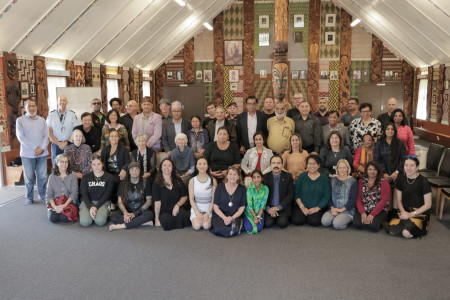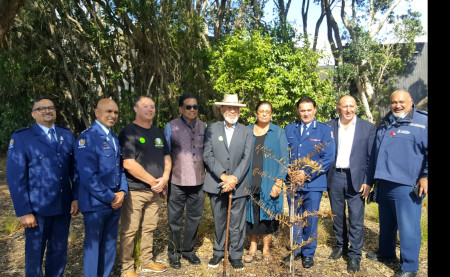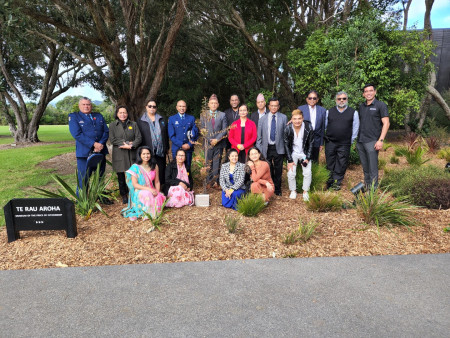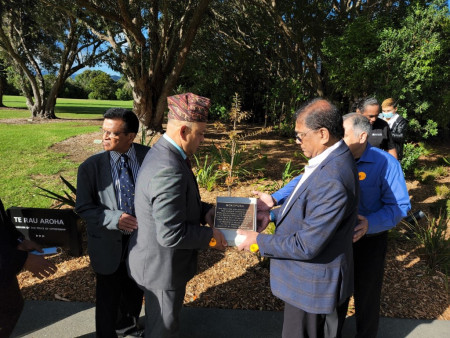Multicultural Federation of New Zealand (MNZ) considers the founding document of Aotearoa in everything it does.
“We feel that the Treaty [of Waitangi] has to be central to our future,” MNZ President Pancha Narayanan says.
 MNZ follows E Tū Whānau values as its members, including many volunteers, work to support migrants and refugees integrate into the communities they live in. It has 26 councils throughout the country, each caring for a specific region.
MNZ follows E Tū Whānau values as its members, including many volunteers, work to support migrants and refugees integrate into the communities they live in. It has 26 councils throughout the country, each caring for a specific region.
It collaborates with iwi, government and other national organisations to support New Zealand’s multicultural communities and is a key stakeholder of the Ministry for Ethnic Communities.
Relationships with Māori and consideration for the Treaty focuses heavily in all its endeavours. One of its early initiatives in this space was to facilitate marae noho visits, which is an overnight stay in a marae.
It’s a way to introduce new migrants to te ao Māori and to ensure they know that Aotearoa is a bicultural nation, Mr Narayanan says.
“I came to New Zealand thinking it was a western society, I didn’t realise the First Nation people had been a deprived culture…I wanted recent migrants to understand that early in their settlement.”
MNZ has facilitated about 60 marae noho visits over the years, and have been surprised by how accepting newcomers have been to the experience.
 At marae, the cultures can blend, with Māori cooking traditionally ethnic food, such as fish curry, stories being shared, and common themes quicky identified.
At marae, the cultures can blend, with Māori cooking traditionally ethnic food, such as fish curry, stories being shared, and common themes quicky identified.
“Māori are also accepting there is so much multiculturalism in Māoridom,” Mr Narayanan says.
“A Treaty-based future is tikanga-based. It is multicultural – Māori also acknowledge that intercultural marriages are now more common amongst Māori.”
In 2021 MNZ leaders came together for a hikoi from Upper Hutt to the Treaty Grounds in Waitangi. Mr Narayanan gets goosebumps as he recounts the story about how the sun shone as they were welcomed on to the grounds, the rain poured as they gathered in the marae, and the clouds lifted as they ventured outside again. The rain had wet the ground, preparing for what was next.
They had visited to pay their respects to the Treaty and were invited by the local iwi to plant a Kauri tree at the entrance to the grounds. The tree, named Mokopuna, the Māori word for grandchildren, symbolises “our connected future”, Mr Narayanan says.
“Anybody who comes there will see their ancestors envisioned a connected future, that New Zealand aspires to open to different cultures but also recognises its heritage and indigenous people.”
 The leaders aim to return every year, to pay their respects to the tree and the grounds and to ensure that Te Tiriti is always in the minds of future MNZ leaders. One day they hope to be invited to Waitangi Day celebrations as guests.
The leaders aim to return every year, to pay their respects to the tree and the grounds and to ensure that Te Tiriti is always in the minds of future MNZ leaders. One day they hope to be invited to Waitangi Day celebrations as guests.
MNZ organises yearly recognition for New Zealanders who demonstrate E Tū Whānau values: aroha, whanaungatanga, whakapapa, mana, manaaki, kōrero awhi and tikanga. It’s its way to “shine the torch” on people who embody these values in their work. Past recipients have included epidemiologist Dr. Michael Baker, Deputy Commissioner of Police, Wallace Haumaha (now retired) and the Black Panthers.
It initiated the annual event Te Tiriti-based Multicultural Day, which is a time for people to share their cultures with others and to celebrate New Zealand’s diversity. But also as a “reminder that New Zealand wants you, and to remember the Treaty-based and tikanga values immigrants can practice,” Mr Narayanan says.
MNZ has an enduring relationship with Māori and has been invited to sign a Memorandum of Understanding with the Iwi Chairs Forum.
“Māori always want to have a long-term relationship,” Mr Narayanan says.
 “That’s why Waitangi is important – it’s a relationship with the land, the nature and the environment.”
“That’s why Waitangi is important – it’s a relationship with the land, the nature and the environment.”
Mr Narayanan encourages New Zealand’s ethnic communities to acknowledge that Aotearoa is a bicultural country, to seek out information about te ao Maori and Te Tiriti and to connect with their local MNZ council and sign up for a noho.
This will be a chance to listen to folklores of local tangata whenua, “and be pleasantly surprised that there are many similarities with your own cultures”.
